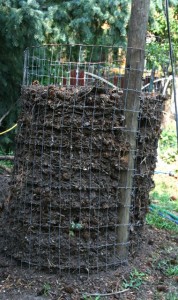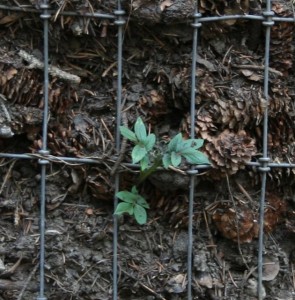Okay, so when most people say (write, text, etc.) “potato tower,” they’re referring to some variation on that time-honored tower-of-tires method, in which one continues to heap earth or straw around a growing spud, using a mounting stack of tires to hold said earth or straw in place, thus allowing more and more new spuds to form along the original’s ever-lengthening stem.
That method is not the subject of this post.
It isn’t that I have nothing to say about the tire-tower; I do, oh, I do. In fact, I have a rant building on the near-ubiquitous nature of this method and its variations (involving wire mesh, newspaper, cardboard boxes, tomato cages, reed mesh, and assorted combinations and permutations of the above), but that rant not having yet reached its finely honed apex, will have to wait. Or we must wait for it. Or something.
In the meantime, I shall try to subdue my rage, curb the temptation to rant, and discuss the other type of potato tower that is the subject of this post. I stumbled on it while mucking about on the web a few weeks back, first on, of all places, Popular Mechanics, and then elsewhere, including Mother Earth News and a blog that’s new to me, Mavis Butterfield’s One Hundred Dollars a Month.
In this version of the tower, you don’t rely on a few potatoes to fill the entire bin. Instead, you put in several layers of potatoes which then grow out the sides of the tower. Having had minimal success in the past with getting potatoes to sprout along a stem as it grows, and having in hand more seed potatoes than made sense, I decided to try this.
Aside from finding enough earth to fill the cylinder (mine must be almost a yard in diameter) this is an easy enough project, largely because I didn’t do it right. Everyone says to line the wire cylinder with straw. Not having any, I didn’t. Instead, I mixed the soil with generous amounts of coconut coir and spruce duff (the layer of decaying needles beneath the tree.) Both hold water beautifully, so I’m hoping the spuds within don’t suffer for lack of straw.
It has taken on a distinct tilt, as you see:
But there at the bottom—yes—a sprout!
That was actually five days ago. The day after this one appeared, I saw another, and two days later a third. Then they started to appear at the top of the tower. So far those three are the only ones poking their leafy heads through the wire into the light, but I have my fingers crossed.


 Subscribe to RSS feed
Subscribe to RSS feed



I have had poor luck with potato towers too. In my experience, they kill off the plants early, with no more potatoes than you had before. I do heavily cover them in straw, though, past their first layer of leaves. This helps keep them from turning green.
You are one funny woman!
My mother has a potato tower in her garden with a straw. It’s OK for now but I haven’t been to her home since the last month. I will check this next time when I go to visit her. Regards!
Great write-up. I don’t know about leaning tower of potatoes. Thanks for sharing the information.
Kate, are you there??
I really like this article and think the idea is pretty ingenious! It’s something I could easily do without having to buy anything except the seed potatoes, which is what I like the most about the idea. I gave the tier tower a shot a few years back and had a beautiful potato plant very few potatoes.
I will give this a shot this year – I’m sure I’ll hve better luck than I did with the tiers.
Thanks!
I think you should be consistently adding soil after every sprout(on the surface) and start with just a couple of cm(20-30). So this way you could stimulate growth and not kill the plant as someone mentioned before me.
Regards
I like this idea and I want to try this at my home garden.This is very unique and relevant idea for growing potatoes and I want you to citation this article by writing about insects which attacks on potato plants.
Thanks for giving this beautiful idea